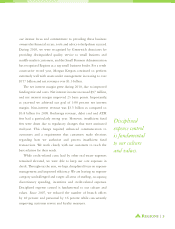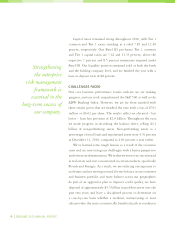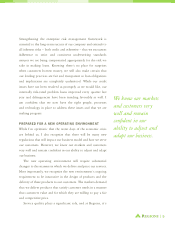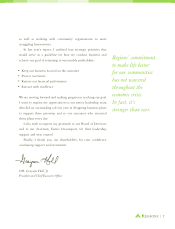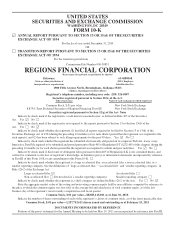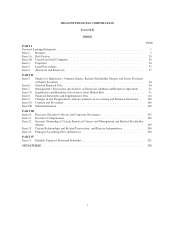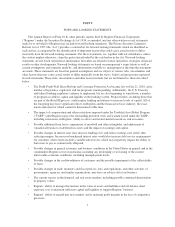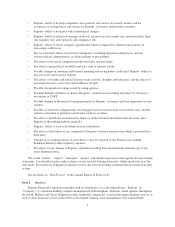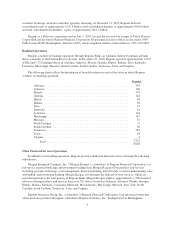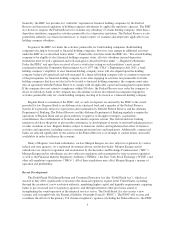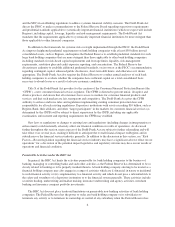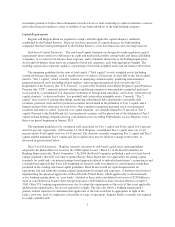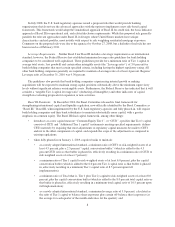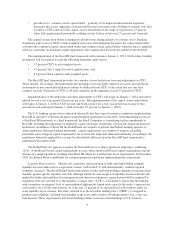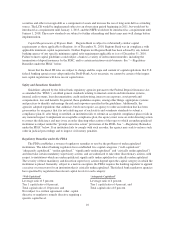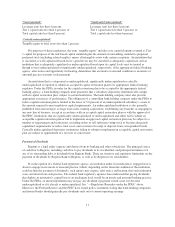Regions Bank 2010 Annual Report Download - page 15
Download and view the complete annual report
Please find page 15 of the 2010 Regions Bank annual report below. You can navigate through the pages in the report by either clicking on the pages listed below, or by using the keyword search tool below to find specific information within the annual report.PART I
FORWARD-LOOKING STATEMENTS
This Annual Report on Form 10-K, other periodic reports filed by Regions Financial Corporation
(“Regions”) under the Securities Exchange Act of 1934, as amended, and any other written or oral statements
made by or on behalf of Regions may include forward-looking statements. The Private Securities Litigation
Reform Act of 1995 (the “Act”) provides a safe harbor for forward-looking statements which are identified as
such and are accompanied by the identification of important factors that could cause actual results to differ
materially from the forward-looking statements. For these statements, we, together with our subsidiaries, unless
the context implies otherwise, claim the protection afforded by the safe harbor in the Act. Forward-looking
statements are not based on historical information, but rather are related to future operations, strategies, financial
results or other developments. Forward-looking statements are based on management’s expectations as well as
certain assumptions and estimates made by, and information available to, management at the time the statements
are made. Those statements are based on general assumptions and are subject to various risks, uncertainties and
other factors that may cause actual results to differ materially from the views, beliefs and projections expressed
in such statements. These risks, uncertainties and other factors include, but are not limited to, those described
below:
• The Dodd-Frank Wall Street Reform and Consumer Protection Act became law on July 21, 2010, and a
number of legislative, regulatory and tax proposals remain pending. Additionally, the U.S. Treasury
and federal banking regulators continue to implement, but are also beginning to wind down, a number
of programs to address capital and liquidity in the banking system. Proposed rules, including those that
are part of the Basel III process, could require banking institutions to increase levels of capital. All of
the foregoing may have significant effects on Regions and the financial services industry, the exact
nature and extent of which cannot be determined at this time.
• The impact of compensation and other restrictions imposed under the Troubled Asset Relief Program
(“TARP”) until Regions repays the outstanding preferred stock and warrant issued under the TARP,
including restrictions on Regions’ ability to attract and retain talented executives and associates.
• Possible additional loan losses, impairment of goodwill and other intangibles, and adjustment of
valuation allowances on deferred tax assets and the impact on earnings and capital.
• Possible changes in interest rates may increase funding costs and reduce earning asset yields, thus
reducing margins. Increases in benchmark interest rates would also increase debt service requirements
for customers whose terms include a variable interest rate, which may negatively impact the ability of
borrowers to pay as contractually obligated.
• Possible changes in general economic and business conditions in the United States in general and in the
communities Regions serves in particular, including any prolonging or worsening of the current
unfavorable economic conditions, including unemployment levels.
• Possible changes in the creditworthiness of customers and the possible impairment of the collectability
of loans.
• Possible changes in trade, monetary and fiscal policies, laws and regulations, and other activities of
governments, agencies, and similar organizations, may have an adverse effect on business.
• The current stresses in the financial and real estate markets, including possible continued deterioration
in property values.
• Regions’ ability to manage fluctuations in the value of assets and liabilities and off-balance sheet
exposure so as to maintain sufficient capital and liquidity to support Regions’ business.
• Regions’ ability to expand into new markets and to maintain profit margins in the face of competitive
pressures.
1


